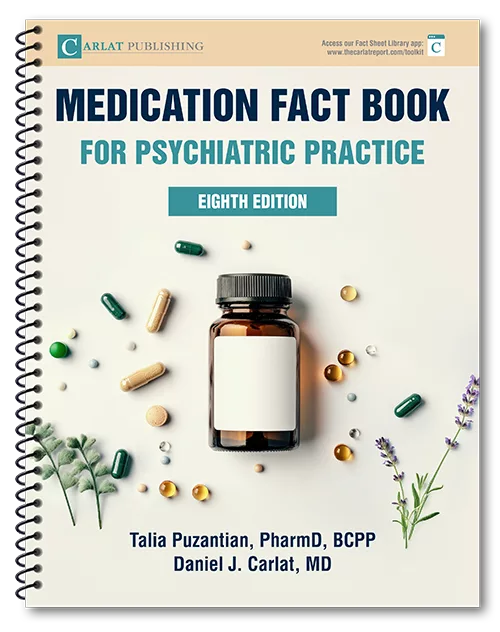We look at the ideal times to intervene for antipsychotic weight gain and panic attacks.
Publication Date: 03/03/2025
Duration: 12 minutes, 50 seconds
Transcript:
KELLIE NEWSOME: Antipsychotic weight gain. Panic disorder. These are tides you have the opportunity to calm before they turn into storm.
Welcome to the Carlat Psychiatry Podcast, keeping psychiatry honest since 2003.
CHRIS AIKEN: I’m Chris Aiken, the editor-in-chief of the Carlat Report.
KELLIE NEWSOME: And I’m Kellie Newsome, a psychiatric NP and a dedicated reader of every issue. In April of 1945, a young US Staff Sergeant arrived at the Dachau concentration camp in Germany. He had already seen 80% of his platoon in killed in combat, but he wasn’t prepared for this next layer of trauma, as he stepped in to figure out who was living and who was dead in the piles of emaciated bodies left by the Nazis. The soldier was JD Salinger, and to deal with the years of trauma he kept a typewriter in his military Jeep, where he worked throughout the war on a novel that would become The Catcher in the Rye. At the end of World War II Salingerwas hospitalized for “battle fatigue,” now known as post-traumatic stress disorder, and his central character HoldenCaulfield appears to narrate his coming-of-age tale from a psychiatric hospital. The Catcher in the Rye barely mentions the war, but the trauma is all there if you read between the lines. Caulfield can’t get the death of his brother out of his mind. It’s the trauma that set him down the ragged path of alienation.
CHRIS AIKEN: And why do we start this podcast with a coming-of-age novel? Because JD Salinger was on to something when he called the book The Catcher in the Rye. The title comes from a Robert Burns poem that Caulfield keeps repeating to himself, “If a body catch a body coming through the rye." Caulfield fantasizes about catching people before they fall off the cliff of adolescence into the harsh realities of adulthood.
KELLIE NEWSOME: Most major mental illnesses begin in the teen years, somewhere between 15-20 for bipolar disorder, schizophrenia, and panic disorder. The brain goes through massive change in those years. Maybe if we can ferry people over those rough waters and safely to the other side they’ll be free of those risks. We see it in studies of identical twins – where one got schizophrenia and the other didn’t – and often, there are clear stresses that pushed one over the edge. You can get a pretty vivid through the 2018 documentary Three Identical Strangers. Researchers have looked at ways to prevent mental illness in people with genetic risks – family therapy, psychotherapy, omega-3, healthy diet, exercise, sleep, darkness at night, and avoiding drugs and head injuries. All have potential. But, there’s a particular window that often shows up in my office that we’re going to focus on here, the first panic attack.
CHRIS AIKEN: Panic disorder and panic attacks are not at all the same thing. 70% of people have had panic attacks. I’ve had them. They are normal, and they don’t even warrant a diagnostic code. But panic disorder is much more rare, around 3%, and it’s defined as a phobia of panic attacks. The person has to go out of their way to avoid them or worry about having them all the time, to meet the criteria. That means that they’re in a constant state of anxiety about them, which causes them to have more panic.
KELLIE NEWSOME: Last week a young man with ADHD rushed into his session with great relief. “I’m so glad I had this appointment with you Kellie because yesterday I had my first panic attack. It came out of nowhere. I felt like something was choking me. I couldn’t breath and my arms were tingling. I went to the emergency room and they said everything was normal and I should talk to you about it.” The first thing to do in this situation is shift the topic from panic to avoidance. I’ll ask if he’s started to avoid things because he’s worried about having a panic attack or if he’s spending all his time worrying about whether he’ll have another one. If he isn’t, I breath a deep sigh of relief. “Good, that means you aren’t having a psychiatric disorder.” If he is, I’ll get real serious about it, “That’s what we need to watch out for because panic attacks are totally normal. It’s your body’s alarm system going off – yes, it’s a false alarm, but it’s good to know that it’s working. Panic disorder is different. That is when you get a full-blown phobia of panic attacks. Panic disorder is a different kind of phobia because it’s a phobia of your own body, so it’s harder to avoid than a phobia of bridges or spiders. I know you want to get rid of the panic attacks entirely, but that isn’t possible. They are a healthy part of you. What we need to get rid of is the phobia, which means you’re going to need to turn this around and stop avoiding things that you think are going to give you a panic attack.”
CHRIS AIKEN: It’s tough to have this conversation without pushing the patient to do what they can’t, or invalidating their fears. I’ll emphasize that phobia here is unconscious – it’s not something they can control or just snap out of – and if they are having significant phobia of panic, it’s a ripe time to start CBT. But a lot of cases turn around quickly with this kind of intervention, and I’ll also give them something they can do to reduce the anxious state. Most patients want something quick, like a Benzo, but if they aren’t having DSM phobic-level panic disorder, I prefer something like light aerobic exercise, deep breathing, or mindfulness to ease the anxiety. If they are not in regular therapy, I will often recommend a mindfulness or anxiety-reducing APP. I keep a list of evidence-based ones at chrisaikenmd.com/apps. No one likes to have panic attacks, even though most people have had them. What we want here is for the patient to shift from the experience of panic attacks as terrifying to basically being annoying. And the analogy of phobia helps her because we can all relate, no one likes to have spiders in their house, but spider phobia or snake phobia is a totally different thing. I will give you an example, I asked one patient I saw, "How have you been doing this week", and she said,"Well, I haven't been out of my house the entire week". I thought she may have had depression, so I said, " What is going on", she explained that she had seen out of her window what had looked like a snake, and she did not leave her house the entire week out of that fear. It turned out that it was a rubber hose, and she could leave. That shows how phobias are extreme, and none of us like snakes or spiders or panic attacks, but that does not mean we have a phobia. It is a very different mindset. Here is one more fact that reminds me of that. It is common for people with panic disorder when they travel about, they have to know exactly where the hospitals and emergency rooms are on their route of travel just to feel safe.
KELLIE NEWSOME: The bottom line. There’s a window of opportunity between the first panic attack and the onset of true panic disorder, and you can help your patients turn things around in that time by reducing avoidance and adding in some anxiolytic lifestyle steps.
Let’s pause for a preview of the CME quiz for this episode. Earn CME for each episode through the link in the show notes.
1. What is the typical age of onset for panic disorder?
A. 5-10 years
B. 15-20 years
C. 20-30 years
D. 40-50 years
Our next window of opportunity is about starting metformin for antipsychotic weight gain.
CHRIS AIKEN: Metformin is a first-line treatment for antipsychotic weight gain, it’s even endorsed in the APA’streatment guidelines for schizophrenia. But it does a much better job at preventing weight gain than at treating it, so it’sbest to start metformin before things get out of hand. Here’s a method that will help there, and will give your patients more control over this dreaded side effect. When starting an antipsychotic, tell your patient that weight gain is not inevitable on these. Even on olanzapine, only half gain significant weight. After all, the medication doesn’t cause weight gain like a high-calorie meal does – instead, it’s largely the interaction between the medication and the person’s genetics that leads to the problem, and short of a genetic test here’s how you can know if your patient is at risk. It comes from a 2015 study by Frederik Vandenberghe and colleagues that uses our favorite World War II technology, the receiver operator curve. Ask your patient to get a careful body weight before starting the med. That means in the morning, before breakfast, after using the bathroom if they have to, and naked on a scale. Then check again one month later using the same exacting method. If they gain 5% or more of their total body weight in that first month, they’re likely to gain a lot more in the years to come. Dr. Vandenberghe repeated this study in adolescents and found a similar threshold of 4% rather than 5% change in body weight as the best predictor for that group.
KELLIE NEWSOME: What do you do if your patient gains 5%? You could switch antipsychotics, start diet and exercise, or if they don’t have a condition that requires long-term antipsychotic use – so, not schizophrenia – you could plan to taper off. Or you could start metformin. As much as we’d like to see diet and exercise shine, we have to admit that metformin outperformed lifestyle interventions. And metformin does more than prevent weight gain. When people on antipsychotics take metformin they have less hyperprolactinemia, better insulin sensitivity, and lower cholesterol and triglyceride levels. The dose is 500mg for a week and then 1000 mg. Take it with food or use an XR version to reduce nausea, the main side effect.
CHRIS AIKEN: Metformin’s window is before weight gain begins, but if your patient is already obese, a GLP-1 agonist like liraglutide, semaglutide, or tripeptide may be in order. They have studies in psychiatric populations, and their use is on-label if your patient’s BMI is 30 or more, or if they have obesity-related health problems the FDA allows a BMI cut-off of 27.
KELLIE NEWSOME: Some clinicians feel that GLP-1 agonists are outside their lane. That’s a personal decision – not one that officials have weighed in on – and it’s fine to defer to primary care for that step. But even if it is outside your lane, it is not off-label, as long as they meet the BMI cut-off. We’ll have a full review on how to use them in psychiatry in an upcoming Carlat issue.
CHRIS AIKEN: The bottom line. Start metformin early, before the weight gain gets out of hand, and you can find out who is at risk for that by checking for a 5% change in body weight after one month on the antipsychotic.
KELLIE NEWSOME: In the last year, we saw two new FDA approvals for medications in dementia. But in the newissue of the Carlat Report Stephanie Collier explains why neither of them are first-line. Read the interview online and get $30 off your subscription with the promo code PODCAST. Also in the March issue is an updated review of stimulant formulations and an updated algorithm on postpartum psychosis. The Carlat Report is one of few CME publications that operates entirely free of industry support.


_-The-Breakthrough-Antipsychotic-That-Could-Change-Everything.webp?t=1729528747)



